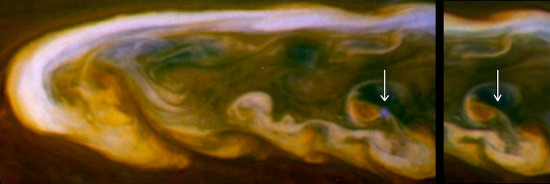Jul 22, 2015
Elves could be found in gas giant atmospheres.
The plasmasphere of Saturn is highly energetic. The Cassini orbiter found lightning up to a million times more powerful than anything on Earth. It is not surprising that the discovery was made, since Saturn emits 2.3 times more energy than it receives from the Sun: 90 megawatts of X-rays were detected by Cassini.
A press release from the time reported that Cassini found charged particles “being accelerated to ultra-high energies”. The impetus experienced by the ions was said to be similar to charged particles that are theoretically “sped up” by the shockwaves from supernovae. However, as has been argued many times in the past, charged particles are best accelerated by electric fields. Laboratory experiments confirm the case.
In an Electric Universe, Saturn is immersed in the Sun’s plasmasphere and interacts with its electric field. Planets and moons in the Solar System are charged bodies; they are not isolated in “empty” space. Enceladus, Dione and Tethys all revolve within Saturn’s plasmasphere, so it is to be expected that they would transact electrically with their primary. The simplest, most straightforward explanation for the charged particle acceleration is electric discharge.
Planetary scientists are aware that plasma makes up more than 99% of the visible Universe, but they have yet to consider the role of charge distribution within the plasma of space. Now, a recent announcement states that gas giant planets in other star systems might also behave like Saturn, creating structures out of electrical forces.
On Earth, massive, diffuse discharge phenomena occur above active thunderstorms, coinciding with normal lightning strokes. They can be single events, or multiple, with filaments above and below, often extending to altitudes close to 100 kilometers. Known as “sprites”, some of the largest contain dozens of individual smaller sprites, covering horizontal distances of 50 kilometers, with a volume of 10,000 cubic kilometers.
Other electric discharge events that take place above thunderheads are “blue jets”. They are distinct from sprites, since they propagate upward in narrow cones that disappear at an altitude of about 50 kilometers. They are also more powerful because the electric discharges are confined within a smaller spatial volume. Geophysicists are beginning to realize that sprites and jets are part of every moderate to large storm system and are an essential component in Earth’s electric circuit.
The largest above-cloud phenomenon was discovered in the upper reaches of Earth’s atmosphere in the early 1990s. Elves appear at the edge of space as enormous, expanding red rings. First recorded from the space shuttle Discovery, the glow can reach 500 kilometers in diameter in 1 millisecond. Elves occur when lightning in a thunderstorm triggers a disturbance in the electric and magnetic fields called an electromagnetic pulse (EMP). This pulse reaches into the upper layers of the Earth’s atmosphere and expands outward, jolting electrons and exciting nitrogen molecules, which emit a faint red glow. The light also provides the grounds for the phenomenon’s whimsical acronym: Emissions of Light and Very low frequency perturbations due to Electromagnetic pulse Sources.
The authors of the aforementioned paper used high speed computer modeling in order to determine if elves can propagate through the environments of Jupiter and Saturn, since lightning has been detected on both planets. Their models found that elves would be larger than those on Earth, nearly 4000 kilometers in diameter. Those results gave them indications that elves might also be found on exoplanets, since stars and gas giants should reveal similar patterns of interaction no matter where they are.
Stephen Smith













